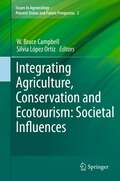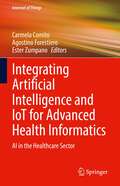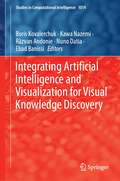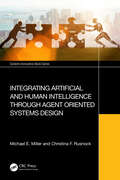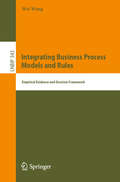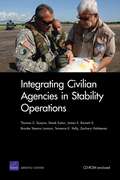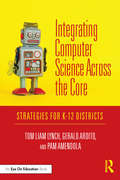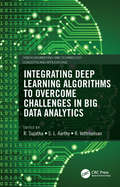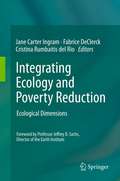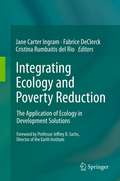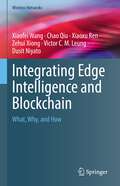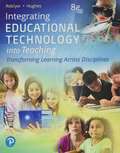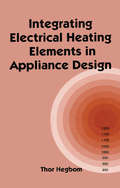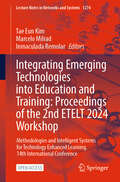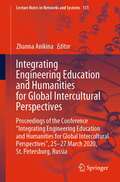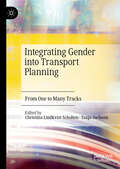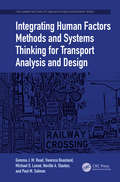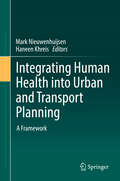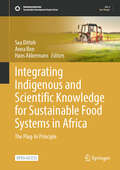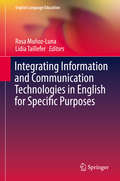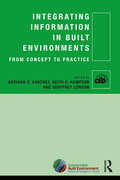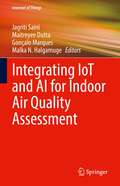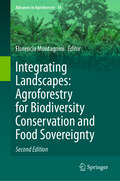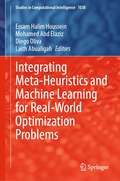- Table View
- List View
Integrating Agriculture, Conservation and Ecotourism: Societal Influences
by W. Bruce Campbell Silvia López OrtízAgroecology not only encompasses aspects of ecology, but the ecology of sustainable food production systems, and related societal and cultural values. To provide effective communication regarding status and advances in this field, connections must be established with many disciplines such as sociology, anthropology, environmental sciences, ethics, agriculture, economics, ecology, rural development, sustainability, policy and education, or integrations of these general themes so as to provide integrated points of view that will help lead to a more sustainable construction of values than conventional economics alone. Such designs are inherently complex and dynamic, and go beyond the individual farm to include landscapes, communities, and biogeographic regions by emphasizing their unique agricultural and ecological values, and their biological, societal, and cultural components and processes.
Integrating Artificial Intelligence and IoT for Advanced Health Informatics: AI in the Healthcare Sector (Internet of Things)
by Carmela Comito Agostino Forestiero Ester ZumpanoThe book covers the integration of Internet of Things (IoT) and Artificial Intelligence (AI) to tackle applications in smart healthcare. The authors discuss efficient means to collect, monitor, control, optimize, model, and predict healthcare data using AI and IoT. The book presents the many advantages and improvements in the smart healthcare field, in which ubiquitous computing and traditional computational methods alone are often inadequate. AI techniques are presented that play a crucial role in dealing with large amounts of heterogeneous, multi-scale and multi-modal data coming from IoT infrastructures. The book is intended to cover how the fusion of IoT and AI allows the design of models, methodologies, algorithms, evaluation benchmarks, and tools can address challenging problems related to health informatics, healthcare, and wellbeing.
Integrating Artificial Intelligence and Visualization for Visual Knowledge Discovery (Studies in Computational Intelligence #1014)
by Ebad Banissi Kawa Nazemi Boris Kovalerchuk Răzvan Andonie Nuno DatiaThis book is devoted to the emerging field of integrated visual knowledge discovery that combines advances in artificial intelligence/machine learning and visualization/visual analytic. A long-standing challenge of artificial intelligence (AI) and machine learning (ML) is explaining models to humans, especially for live-critical applications like health care. A model explanation is fundamentally human activity, not only an algorithmic one. As current deep learning studies demonstrate, it makes the paradigm based on the visual methods critically important to address this challenge. In general, visual approaches are critical for discovering explainable high-dimensional patterns in all types in high-dimensional data offering "n-D glasses," where preserving high-dimensional data properties and relations in visualizations is a major challenge. The current progress opens a fantastic opportunity in this domain. This book is a collection of 25 extended works of over 70 scholars presented at AI and visual analytics related symposia at the recent International Information Visualization Conferences with the goal of moving this integration to the next level. The sections of this book cover integrated systems, supervised learning, unsupervised learning, optimization, and evaluation of visualizations. The intended audience for this collection includes those developing and using emerging AI/machine learning and visualization methods. Scientists, practitioners, and students can find multiple examples of the current integration of AI/machine learning and visualization for visual knowledge discovery. The book provides a vision of future directions in this domain. New researchers will find here an inspiration to join the profession and to be involved for further development. Instructors in AI/ML and visualization classes can use it as a supplementary source in their undergraduate and graduate classes.
Integrating Artificial and Human Intelligence through Agent Oriented Systems Design (Systems Innovation Book Series)
by Michael E. Miller Christina F. RusnockThis book departs from the assumption that Artificial Intelligence (AI) systems will provide a maximum advantage by replacing human cognitive processing. Instead, this book subscribes to the assumption that AI systems will provide a maximal advantage when the system is specifically designed to augment human intelligence. It provides methods for designing effective systems that include one or more humans and one or more AI entities and uses the approach that assumes automation does not replace human activity but fundamentally changes the structure of human work when AI is added to existing systems.Integrating Artificial and Human Intelligence through Agent Oriented Systems Design discusses the potential impact of AI on human work and life and explores why teamwork is necessary today for complex work environments. The book explains the processes and methods humans employ to effectively team with one another and presents the elements of artificial agents that permit them to function as team members in joint human and artificial teams. It discusses design goals and illustrates how the methods that have been used to model the complex interactions among human and artificial agents can be expanded to enable the design of interaction between them to make possible the attainment of the shared goals. Model-Based Systems Engineering (MBSE) tools that provide logical designs of human–agent teams, the AI within these teams, training to be deployed for human and artificial agent team members, and the interfaces between human and artificial agent team members are all covered. MBSE files containing profiles and examples for building MBSE models used in the design approach are featured on the author’s website (https://lodesterresci.com/hat).This book is an ideal read for students, professors, engineers, and project managers associated with designing and developing AI systems or systems that seek to incorporate AI.
Integrating Blockchain and Artificial Intelligence for Industry 4.0 Innovations (EAI/Springer Innovations in Communication and Computing)
by Sam Goundar R. AnandanThis book discusses the convergence of artificial intelligence (AI) and Blockchain and how they can work together to help reach the goals of Industry 4.0. The authors first discuss how AI and Blockchain can help increase performance in business. The authors go on to discuss how the technologies can integrate to provide a competitive edge for businesses through improvements in big data, which has allowed firms to organize huge datasets into structured components that computers can process quickly. The authors also cover security implications and how AI and Blockchain can act as a double-edged sword against cyber-attacks. Impacts in programming, calculations, robotization, robots, and equipment are also discussed. This book caters to an extensive cross-sectional and multi-disciplinary readership. Academics, researchers and their students in topics such as artificial intelligence, cyber-physical systems, ethics, robotics, safety engineering, and safety-critical systems should find the book of value.
Integrating Business Process Models and Rules: Empirical Evidence And Decision Framework (Lecture Notes in Business Information Processing #343)
by Wei WangThis book combines multiple research methods, experiment, survey, and design science, as well as traditional measurements and neurophysiological techniques that can capture a variety of cognitive behaviors in human information processing, providing more solid and comprehended research findings. While the focus of the book is the modelling of process models and rules, the methods and techniques used in this book can also be adopted and applied to broader conceptual modelling research incorporating a variety of notations (e.g. UML, ER diagrams) or ontologies.It is a revised version of the PhD dissertation written by the author at the School of Information Technology and Electrical Engineering of the University of Queensland, Australia. In 2018, the PhD dissertation won the "CAiSE PhD Award," granted to outstanding PhD theses in the field of information systems engineering.
Integrating Civilian Agencies in Stability Operations
by Terrence K. Kelly Derek Eaton Brooke Stearns Lawson Thomas S. Szayna James E. BarnettHow can the Army help make key civilian agencies more capable partners in stability, security, transition, and reconstruction (SSTR) operations? The authors identify the civilian agencies that should be involved in such operations, then locate the necessary skill sets. They then assess the capacity of the civilian agencies to participate in SSTR operations and analyze the recurring structural problems that have plagued their attempts to do so.
Integrating Computer Science Across the Core: Strategies for K-12 Districts
by Tom Liam Lynch Gerald Ardito Pam AmendolaIntegrating Computer Science Across the Core is a guide to systematizing computer science and computational thinking practices in your school. While most books explain how to teach computer science as a stand-alone discipline, this innovative approach will help you leverage your existing curriculum to deepen and expand students’ learning experiences in all content areas. Effective, equitable, and sustainable, this blueprint provides principals, curriculum directors, directors of technology, and other members of your school or district leadership team with suggested organizational structures, tips for professional learning, and key resources like planning instruments.
Integrating Deep Learning Algorithms to Overcome Challenges in Big Data Analytics (Green Engineering and Technology)
by R. SujathaData science revolves around two giants: Big Data analytics and Deep Learning. It is becoming challenging to handle and retrieve useful information due to how fast data is expanding. This book presents the technologies and tools to simplify and streamline the formation of Big Data as well as Deep Learning systems. This book discusses how Big Data and Deep Learning hold the potential to significantly increase data understanding and decision-making. It also covers numerous applications in healthcare, education, communication, media, and entertainment. Integrating Deep Learning Algorithms to Overcome Challenges in Big Data Analytics offers innovative platforms for integrating Big Data and Deep Learning and presents issues related to adequate data storage, semantic indexing, data tagging, and fast information retrieval. FEATURES Provides insight into the skill set that leverages one’s strength to act as a good data analyst Discusses how Big Data and Deep Learning hold the potential to significantly increase data understanding and help in decision-making Covers numerous potential applications in healthcare, education, communication, media, and entertainment Offers innovative platforms for integrating Big Data and Deep Learning Presents issues related to adequate data storage, semantic indexing, data tagging, and fast information retrieval from Big Data This book is aimed at industry professionals, academics, research scholars, system modelers, and simulation experts.
Integrating Ecology and Poverty Reduction: Ecological Dimensions
by Cristina Rumbaitis del Rio Fabrice Declerck Jane Carter IngramIn the past, the science of ecology has frequently been excluded from the development agenda for various reasons. Increasingly however there has been a renewed interest in finding more ecologically sustainable means of development that have required a strong foundation in ecological knowledge (for example EcoAgriculture Partnerships, EcoHealth presented at ESA, and EcoNutrition proposed by Deckelbaum et al). Each of these examples has already taken the critical first step at integrating ecological knowledge with agriculture, health and nutrition, respectively. However, this is only the first step; more attention needs to be placed not only on the role that two fields can play towards poverty alleviation, but on the role of a truly integrated, interdisciplinary approach towards development goals that is firmly grounded in ecological understanding. We feel that a critical look at what ecology can and cannot provide to the development agenda, in light of the Millennium Development goals, is timely and crucial. The introduction and the final section of the book will then integrate the lessons and principles outlined in each of the chapters. All chapter authors will be heavily encouraged to focus on how their sub-discipline in ecology impacts overall human well-being and environmental sustainability.
Integrating Ecology and Poverty Reduction: The Application of Ecology in Development Solutions
by Cristina Rumbaitis del Rio Fabrice Declerck Jane Carter IngramIn the past, the science of ecology has frequently been excluded from the development agenda for various reasons. Increasingly however there has been a renewed interest in finding more ecologically sustainable means of development that have required a strong foundation in ecological knowledge (for example EcoAgriculture Partnerships, EcoHealth presented at ESA, and EcoNutrition proposed by Deckelbaum et al). Each of these examples has already taken the critical first step at integrating ecological knowledge with agriculture, health and nutrition, respectively. However, this is only the first step; more attention needs to be placed not only on the role that two fields can play towards poverty alleviation, but on the role of a truly integrated, interdisciplinary approach towards development goals that is firmly grounded in ecological understanding. We feel that a critical look at what ecology can and cannot provide to the development agenda, in light of the Millennium Development goals, is timely and crucial. The introduction and the final section of the book will then integrate the lessons and principles outlined in each of the chapters. All chapter authors will be heavily encouraged to focus on how their sub-discipline in ecology impacts overall human well-being and environmental sustainability.
Integrating Edge Intelligence and Blockchain: What, Why, and How (Wireless Networks)
by Dusit Niyato Xiaofei Wang Victor C. Leung Chao Qiu Xiaoxu Ren Zehui XiongThis book examines whether the integration of edge intelligence (EI) and blockchain (BC) can open up new horizons for providing ubiquitous intelligent services. Accordingly, the authors conduct a summarization of the recent research efforts on the existing works for EI and BC, further painting a comprehensive picture of the limitation of EI and why BC could benefit EI. To examine how to integrate EI and BC, the authors discuss the BC-driven EI and tailoring BC to EI, including an overview, motivations, and integrated frameworks. Finally, some challenges and future directions are explored. The book explores the technologies associated with the integrated system between EI and BC, and further bridges the gap between immature BC and EI-amicable BC.Explores the integration of edge intelligence (EI) and blockchain (BC), including their integrated motivations, frameworks and challenges;Presents how BC-driven EI can realize computing-power management, data administration, and model optimization;Describes how to tailor BC to better support EI, including flexible consensus protocol, effective incentive mechanism, intellectuality smart contract, and scalable BC system tailoring;Presents some key research challenges and future directions for the integrated system.
Integrating Educational Technology Into Teaching
by M. Roblyer Joan HughesA balance of theory, research, and classroom practice helps teachers understand the most effective ways to integrate educational technology Long recognized in the field as the leading educational technology text, Integrating Educational Technology into Teaching links technology integration strategies to specific learning theories, shows pre- and in-service teachers how to plan for technology integration, and offers opportunities to practice integrating technology by designing curriculum to meet teaching and learning needs. Carefully selected exercises, sample lessons, and recommended resources encourage teachers to reflect on their practice as they develop the insights, knowledge, and skills they need to infuse technology across all disciplines. The 8th Edition features updated technology integration and assessment frameworks, helping teachers employ technology in a way that revitalizes students’ interest and engagement in learning. Throughout the book, content is updated to align with the latest ISTE Standards for Educators and Students and showcases the most current tools, methods, and ideas shaping the role of technology in education. Integrating Educational Technology into Teachingis also available via Revel™–an interactive learning environment that enables students to read, practice, and study in one continuous experience.
Integrating Electrical Heating Elements in Product Design (ISSN #Vol. 101)
by Thor HegbomOffers details on the utilization of electrical heating elements in consumer appliance design and industrial processes. The text includes basic theory, metallurgy and production advice for developing more reliable and cost-effective heaters. It provides tables comparing resistivity and surface resistance of different materials, and listing the resistance and weight per metre as well as surface per ohm of whole and half B&S wire and ribbon sizes for common standard resistance heating alloys. The book also contains calculation equations suitable for use in BASIC programs.
Integrating Emerging Technologies into Education and Training: Methodologies and Intelligent Systems for Technology Enhanced Learning, 14th International Conference (Lecture Notes in Networks and Systems #1274)
by Marcelo Milrad Tae Eun Kim Inmaculada RemolarThis open access book compiles state-of-the-art research on the development and implementation of advanced learning technologies and AI-assisted tools, showing how they can transform the educational landscape and learning processes in various domains. Covering topics ranging from immersive learning environments to personalized education, it offers insights and practical applications that are shaping the future of classrooms and training programs. This book provides research insights on harnessing emerging technology’s potential to enhance education, and it is an essential reading for educators, researchers, and edu-tech professionals.
Integrating Engineering Education and Humanities for Global Intercultural Perspectives: Proceedings of the Conference “Integrating Engineering Education and Humanities for Global Intercultural Perspectives”, 25-27 March 2020, St. Petersburg, Russia (Lecture Notes in Networks and Systems #131)
by Zhanna AnikinaThis book presents papers from the International Conference on Integrating Engineering Education and Humanities for Global Intercultural Perspectives (IEEHGIP 2020), held on 25–27 March 2020. The conference brought together researchers and practitioners from various disciplines within engineering and humanities to offer a range of perspectives. Focusing on, but not limited to, Content and Language Integrated Learning (CLIL) in Russian education the book will appeal to a wide academic audience seeking ways to initiate positive changes in education.
Integrating Gender into Transport Planning: From One to Many Tracks
by Christina Lindkvist Scholten Tanja JoelssonThis edited collection brings together feminist research on transport and planning from different epistemologies, with the intention to contribute to a more holistic transport planning practice. With a feminist perspective on transport policy and planning, the volume insists on the political character of transport planning and policy, and challenges gender-blindness in a policy area that impacts the everyday lives of women, men, girls, and boys. The chapters discuss everyday mobility as an embodied and situated activity in both conceptual and theoretical ways and suggest practical tools for change. The contributions of this collection are threefold: integrating gender research and transport planning, combining quantitative and qualitative gender research perspectives and methods, and highlighting the need to acknowledge the politicization of transport planning and transport practice.
Integrating Human Factors Methods and Systems Thinking for Transport Analysis and Design (The Human Factors, Simulation and Performance Assessment Series)
by Neville A. Stanton Paul M. Salmon Michael G. Lenné Gemma J. Read Vanessa BeanlandGovernments and road safety agencies around the world have either introduced or are considering 'safe system' strategies, a long overdue acknowledgement that different elements of the road system contribute to road safety outcomes. Human factors approaches have a leading role here in both conceptualising the road system as a complex sociotechnical system and in providing practical approaches to support true systems-based countermeasures. This book illustrates the potential for integrating contemporary systems-based human factors methods with modern day driving-assessment methods, such as vehicle instrumentation and driving simulation, to understand and enhance performance in modern day road-transport systems. The book outlines why a fundamental paradigm shift is needed in the way these systems are designed and operated, and illustrates how a wide range of accepted human-factors approaches can be applied successfully to road transport to revolutionise the countermeasure design process. The practical illustrations of these human factors methods are applied to a long-standing road and rail safety issue: rail level crossings, where the road and rail systems intersect. The final chapter of the book highlights the utility of the human factors approach to reducing road trauma and discusses future applications of the approach.
Integrating Human Health into Urban and Transport Planning: A Framework
by Mark Nieuwenhuijsen Haneen KhreisThis volume brings together the world’s leading experts on urban and transport planning, environmental exposures, physical activity, health and health impact assessment to discuss challenges and solutions in cities. The book provides a conceptual framework and work program for actions and outlines future research needs. It presents the current evidence-base, the benefits of and numerous case studies on integrating health and the environment into urban development and transport planning. Within cities there is a considerable variation in the levels of environmental exposures such as ambient air pollution, noise, and temperature, green space availability and physical activity. Many of these exposures, and their adverse health impacts, are related to and are being exacerbated by urban and transport planning and policy. Emerging research suggests that urban and transport planning indicators such as road network, distance to major roads, traffic density, household density, industry, and natural and green space can explain a large proportion of the variability in environmental exposures and therefore represent important and highly modifiable factors. The urban environment is a complex interlinked system. Decision-makers need not only better data on the complexity of factors in environmental and developmental processes affecting human health, but also an enhanced understanding of the linkages between these factors and health effects to determine at which level to target their actions most effectively. In recent years, there also has been a shift from trying to change at the national level to more comprehensive and ambitious actions being developed and implemented at the regional and local levels. Cities have come to the forefront of providing solutions for environmental issues such as climate change, which has co-benefits for health, but yet need better knowledge for wider health-centric action. This book provides the latest and most up-to-date information and studies for academics and practitioners alike.
Integrating Indigenous and Scientific Knowledge for Sustainable Food Systems in Africa: The Plug-In Principle (Sustainable Development Goals Series)
by Saa Dittoh Anna Bon Hans AkkermansThis open access book presents a novel approach to food security research (SDG-2 Zero Hunger) by integrating indigenous and scientific knowledge. Through extensive field-based research in Burkina Faso, Ghana, Kenya, Mali, and South Africa, it explores the impact of merging traditional practices and local knowledge with scientific methods. Through field studies, the book shows the value of local knowledge and community-led innovations in combating hunger, achieving food security, and enhancing nutrition sustainably and food sovereignty. Drawing on decades of research in rural Africa, the authors introduce the "Plug-In Principle"—a theory for integrating indigenous and modern knowledge systems to foster sustainable agricultural practices and enriched food ecosystems in Africa. The Plug-In Principle advocates that advancements in science and technology should enhance rather than replace existing indigenous knowledge. This principle emerged from the failures of many development interventions where attempts at replacement often led to challenges and failures. In agriculture, for instance, interventions in mechanization, soil amendments, seed and breed improvements, and extension services have seldom succeeded due to a lack of integration with existing practices. The Plug-In Principle emphasizes that effective knowledge integration hinges on a deep understanding and appreciation of prevailing systems. By designing interventions that seamlessly "plug-in" to existing technologies, we can ensure the co-creation of effective solutions to the challenges we face. This book is a testament to the potential of collaborative innovation in fostering sustainable development. Development workers, policymakers, researchers, students, and donor agencies in agriculture and other development areas will find this volume invaluable. Additionally, scholars focused on decolonization and indigenous knowledge in the Global South will uncover insightful case studies and analyses.
Integrating Information and Communication Technologies in English for Specific Purposes (English Language Education #10)
by Rosa Muñoz-Luna Lidia TailleferThis book fills the need for a text that integrates Information and Communication Technologies (ICTs) into English for Specific Purposes (ESP). It offers insights on current methodological principles in ESP in both academic and professional contexts, drawing on authentic teaching and learning situations, and analyses best practice guidelines. Part I begins with ESP pedagogical principles and technological practice in order to focus on its two main branches: English for Academic Purposes, which includes linguistic skills and students’ needs, and English for Occupational Purposes, specifically looking at Business, Medical and Translators courses. This book is a great resource for ESP researchers, educators and students, because it provides case studies of how ICTs can be used in English for multiple purposes. Authors present their experiences of integrating tools into their instructions, with each chapter contributing unique pedagogical implications.
Integrating Information in Built Environments (Cib Ser.)
by Adriana X Sanchez Keith Hampson Geoffrey LondonIn an increasingly globalised built environment industry, achieving higher levels of integration across organisational and software boundaries can lead to improved economic, social and environmental outcomes. This book is the direct result of a collaborative global network of industry and academic researchers spread across nine countries as part of CIB’s (International Council for Research and Innovation in Building and Construction) Task Group 90 (TG90) Information Integration in Construction (IICON). The book provides a broad view of some of the opportunities and challenges brought by integrating information across organisational and system boundaries in the built environment industry. Chapters cover a large range of topics and are separated into three sections: resources, processes and added value. They provide a much-needed international perspective on a current global evolution in the industry and present leading original research and valuable lessons for researchers, industry practitioners, government clients and policy makers across the industry. Key features include: a broad range of topics that are not covered elsewhere in the literature; contributions from a diverse group of industry research leaders from across the globe; exemplar case studies providing real-world examples of where information integration has been a key factor for success or lack thereof has been at the root cause of failure; an analysis of future priority areas for research and development investment as well as their strategic implications for public and private decision-makers; the book will deliver innovation in best practice methodology for information sharing across disciplines and between the design, construction and asset management sectors.
Integrating IoT and AI for Indoor Air Quality Assessment (Internet of Things)
by Malka N. Halgamuge Maitreyee Dutta Gonçalo Marques Jagriti SainiThis book presents Internet of Things (IoT) solutions monitoring and assessing a variety of applications areas for indoor air quality (IAQ). This book synthesizes recent developments, presents case studies, and discusses new methods in the area of air quality monitoring, all the while addressing public health concerns. The authors discuss the issues and solutions, including IoT systems that can provide a continuous flow of data retrieved from cost-effective sensors that can be used in multiple applications.The authors present the leading IoT technologies, applications, algorithms, systems, and future scope in this multi-disciplinary domain.
Integrating Landscapes: Agroforestry for Biodiversity Conservation and Food Sovereignty (Advances in Agroforestry #14)
by Florencia MontagniniThis updated and expanded second edition summarizes advances in agroforestry research and practice and proposes alternatives to increase the effectiveness of agroforestry systems. It offers an important contribution to help solve the most pressing development and environmental challenges in this sector today. The contributing authors present views from the academic, the practitioner and the development areas. Chapters offer alternatives and suggestions for facing challenges in agroforestry adoption, profitability, and in the implementation of integrated landscape management approaches.With new chapters and substantial revisions made in many others, the scope was broadened both geographically and thematically. Students, Scientists and practitioners will therefore gain more insights from Africa and Asia, as well as the Americas.
Integrating Meta-Heuristics and Machine Learning for Real-World Optimization Problems (Studies in Computational Intelligence #1038)
by Diego Oliva Mohamed Abd Elaziz Laith Abualigah Essam Halim HousseinThis book collects different methodologies that permit metaheuristics and machine learning to solve real-world problems. This book has exciting chapters that employ evolutionary and swarm optimization tools combined with machine learning techniques. The fields of applications are from distribution systems until medical diagnosis, and they are also included different surveys and literature reviews that will enrich the reader. Besides, cutting-edge methods such as neuroevolutionary and IoT implementations are presented in some chapters. In this sense, the book provides theory and practical content with novel machine learning and metaheuristic algorithms. The chapters were compiled using a scientific perspective. Accordingly, the book is primarily intended for undergraduate and postgraduate students of Science, Engineering, and Computational Mathematics and can be used in courses on Artificial Intelligence, Advanced Machine Learning, among others. Likewise, the material can be helpful for research from the evolutionary computation, artificial intelligence communities.
